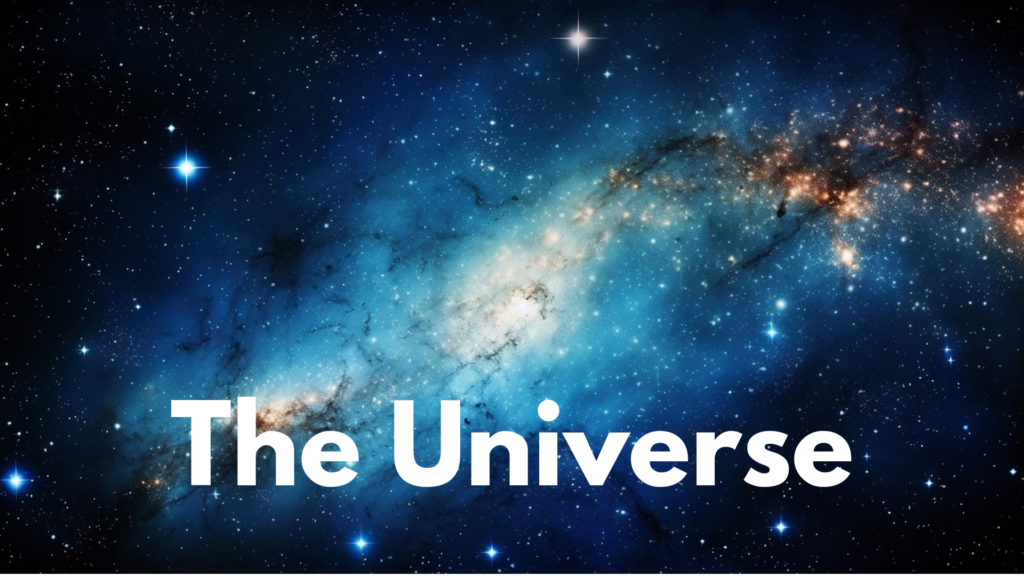

The Big Bang, which created the universe as we know it today, occurred some 13.8 billion years ago. This was an enormous expansion from a very hot and dense condition rather than an explosion in the traditional sense. The universe was in a singularity—a point of infinite temperature and density—prior to the Big Bang. Such severe conditions cause the laws of physics as we know them to break down, making it challenging to explain what happened at the exact instant of the Big Bang.
Formation of Universe: From Quarks to Galaxies
1. The First Few Moments
The universe experienced rapid inflation and experienced exponential expansion in the initial fractions of a second following the Big Bang. The temperature was so high at this period that basic particles like quarks and gluons were unable to organize into stable forms.
2. Formation of Basic Particles
Within the initial few minutes of the universe’s expansion and cooling, quarks joined to form protons and neutrons. Nucleosynthesis is the term for this process. The nuclei of the simplest elements, such as hydrogen, helium, and trace amounts of lithium, were subsequently produced by these protons and neutrons.
3. The Dark Ages
After nucleosynthesis, the universe went through a phase called the “Dark Ages.” The universe was once made entirely of hot, opaque plasma made up of protons, electrons, and photons. The universe did not cool down sufficiently for electrons to unite with protons to form neutral hydrogen atoms until around 380,000 years after the Big Bang. The cosmic microwave background radiation, which is still visible to us today, was released as a result of a process known as recombination, which let light to move freely.
4. Formation of Stars and Galaxies
Following recombination, the universe kept expanding and cooling. Gravity caused small density fluctuations that had been present since the beginning of the universe to expand, which ultimately resulted in the development of the first stars and galaxies. The early stars were enormous and had brief lives; they are referred to as Population III stars. They were essential in the reionization of the universe and the nuclear fusion process that produced heavier elements.
Components of The Universe
1. Ordinary Matter
Baryonic matter, another name for ordinary matter, accounts for approximately 4.9% of the universe’s total mass-energy content. This encompasses every element present in planets, stars, and living things. It is mostly made up of electrons, protons, and neutrons.
2. Dark Matter
Roughly 26.8% of the mass-energy content of the cosmos is made up of dark matter. Since it doesn’t emit, absorb, or reflect light, modern astronomical tools are unable to see it. On the other hand, evidence of its existence is derived from its gravitational pull on observable stuff, including galaxy rotation curves and the gravitational lensing of light from far-off objects.
3. Dark Energy
With dark energy accounting for roughly 68.3% of the universe’s total mass-energy content, it is the most enigmatic component. It is thought to be the cause of the universe’s accelerated expansion. One of the fundamental mysteries in cosmology is the precise nature of dark energy.
4. Cosmic Structures
There are several scales at which the cosmos is organized, ranging from stars and planetary systems to galaxies and galaxy clusters. Galaxies are systems of stars, gas, dust, and dark matter that are gravitationally bonded together. They might be spiral, elliptical, or irregular galaxies, and they can vary in size. The Milky Way, our own galaxy, is a barred spiral galaxy.
Major Celestial Objects in The Universe
1. Stars
A star is an astronomical object composed primarily of hydrogen and helium, undergoing nuclear fusion reactions in its core, which generate the immense energy that makes it shine. Stars are fundamental components of galaxies and play a crucial role in the cosmos by producing light, heat, and the heavier elements that are essential for the formation of planets and life.
2. Planets
A planet is a celestial entity that orbits a star, has enough mass to cause gravity to shape it into a roughly spherical shape, and has cleared its orbit of other debris. Planets differ in composition, size, and properties, and they are essential components of solar systems.
3. Moons
A moon is a natural satellite that orbits a planet or a dwarf planet. Moons vary greatly in size, composition, and number across different planetary systems. Earth’s moon, commonly referred to as “the Moon,” is the fifth-largest moon in the solar system and the only one that humans have visited.
4. Dwarf Planets
A dwarf planet is a type of celestial body that shares several characteristics with traditional planets but does not meet all the criteria defined by the International Astronomical Union (IAU). According to the IAU’s 2006 classification, a dwarf planet is a celestial object that:
5. Asteroids
An asteroid is a small, rocky object that orbits the Sun, primarily found in the asteroid belt, a region between the orbits of Mars and Jupiter. Asteroids are remnants from the early solar system, leftover material that never coalesced into planets due to gravitational disturbances, primarily from Jupiter. These rocky bodies vary widely in size, shape, and composition, and are considered crucial to understanding the formation and evolution of the solar system.
6. Comets
A comet is a small celestial body composed of ice, dust, and rocky material that orbits the Sun, often in highly elongated elliptical paths. When a comet approaches the inner solar system, the heat from the Sun causes its frozen components to vaporize, creating a visible coma (a glowing cloud of gas and dust) and sometimes a tail that points away from the Sun. Comets are fascinating remnants from the formation of the solar system, offering valuable insights into its early conditions and evolution.
7. Black Holes
A black hole is a region in space where the gravitational pull is so intense that nothing, not even light, can escape from it. Black holes are formed when massive stars collapse under their own gravity after exhausting their nuclear fuel. The concept of a black hole was first predicted by the theory of general relativity, proposed by Albert Einstein in 1915, and they have since become key objects of study in astrophysics due to their mysterious nature and extreme properties.
8. Nebulae
Huge clouds of gas and dust in space are known as nebulae. They are frequently where stars are born. The Eagle Nebula and the Orion Nebula are two well-known examples.
9. Galaxies
A galaxy is a vast system of stars, stellar remnants, interstellar gas, dust, and dark matter, all bound together by gravity. Galaxies vary enormously in size, shape, and structure, containing anywhere from millions to trillions of stars. They are the fundamental building blocks of the universe and play a central role in our understanding of cosmic evolution and structure.
The Fate of The Universe
The characteristics of dark energy and the total density of matter and energy determine the universe’s eventual destiny. There are numerous scenarios that could occur:
1. The Big Freeze (or Heat Death): Galaxies will get farther apart if the expansion keeps speeding up, and as stars burn out, the cosmos will eventually cool. The universe will eventually become a cold, dark, and empty place over trillions of years.
2. The Big Crunch: Gravitational pull may eventually stop the universe’s expansion and force it to collapse back into a hot, dense state, possibly resulting in another Big Bang, if the universe’s density is high enough.
3. The Big Rip: Dark energy has the potential to someday overwhelm all other forces and split galaxies, stars, planets, and even individual atoms apart if its repulsive force keeps growing.
Conclusion
Over billions of years, the hot, dense condition of the universe gave way to the richly structured cosmos we see today. The universe is a large and dynamic organism. There are still a lot of unanswered concerns, especially about the nature of dark matter and dark energy, even with the tremendous advances in our understanding. With advancements in technology and observational methods, we are able to learn more about the cosmos and its beginnings, development, and final destiny.
